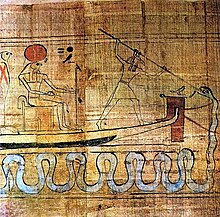Type a search term to find related articles by LIMS subject matter experts gathered from the most trusted and dynamic collaboration tools in the laboratory informatics industry.
| Apep | ||||
|---|---|---|---|---|
Personification of Darkness and Disorder | ||||
 A depiction of Apep based on the depiction in the tomb of Ramesses I. | ||||
| Name in hieroglyphs |
| |||
| Abode | Duat | |||
| Symbol | Snake | |||
| Texts | Spells of Coming Forth by Day | |||
| Genealogy | ||||
| Parents | None, Neith (in some myths) | |||
| Siblings | Ra[dubious – discuss] | |||
| Part of a series on |
| Ancient Egyptian religion |
|---|
 |
|
|
Apep (Ancient Egyptian: ꜥꜣpp), also known as Aphoph (/ə.ˈfɒf/, Coptic: Ⲁⲫⲱⲫ, romanized: Aphōph)[1] or Apophis (/ə.ˈpɒ.fɪs/; Ancient Greek: Ἄποφις, romanized: Ápophis), is the ancient Egyptian deity who embodied darkness and disorder, and was thus the opponent of light and Maat (order/truth). Ra was the bringer of light and hence the biggest opposer of Apep.
Because Ra was the solar deity, bringer of light, and thus the upholder of Maat, Apep was viewed as the greatest enemy of Ra, and thus was given the title Enemy of Ra, and also "the Lord of Chaos".
"The Lord of Chaos" was seen as a giant snake or serpent leading to such titles as Serpent from the Nile and Evil Dragon. Some elaborations said that he stretched 16 yards in length and had a head made of flint.
Presented on a Naqada I (c. 4000–3550 BCE) C-ware bowl (now in Cairo) a snake was painted on the inside rim combined with other desert and aquatic animals as an enemy of a deity, seemingly a solar deity, who is invisibly hunting in a big rowing vessel.[3] The snake on the inside rim is believed to be Apep.
The few descriptions of Apep's origin in myth usually demonstrate that it was born after Re, usually from his umbilical cord. Geraldine Pinch claims that a much later creation myth explained that, "Apophis sprang from the saliva of the goddess Neith when she was still in the primeval waters. Her spit became a snake 120 yards long."[4] But Apep was commonly believed to have existed from the beginning of time in the waters of Nu of primeval chaos.[5]


Tales of Apep's battles against Re were elaborated during the New Kingdom.[7] Storytellers said that every day Apep must lie below the horizon and not persist in the mortal kingdom. This appropriately made him a part of the underworld. In some stories, Apep waited for Re in a western mountain called Manu, where the sun set, and in others, Apep lurked just before dawn, in the Tenth region of the Night. The wide range of Apep's possible locations gained him the title World-Encircler. It was thought that his terrifying roar would cause the underworld to rumble. Myths sometimes say that Apep was trapped there, because he had been the previous chief god overthrown by Re, or because he was evil and had been imprisoned.
The Coffin Texts imply that Apep used a magical gaze to overwhelm Re and his entourage.[8] Re was assisted by a number of defenders who travelled with him, including Set and possibly the Eye of Re.[9] Apep's movements were thought to cause earthquakes, and his battles with Set may have been meant to explain the origin of thunderstorms.[10] In one account, Re himself defeats Apep in the form of a cat.[11]
Re's victory each night was thought to be ensured by the prayers of the Egyptian priests and worshippers at temples. The Egyptians practiced a number of rituals and superstitions that were thought to ward off Apep, and aid Re in continuing his journey across the sky.[12]
In an annual rite called the Ritual of Overthrowing Apophis, priests would build an effigy of Apep that was thought to contain all of the evil and darkness in Egypt, and burn it to protect everyone from Apep's evil for another year.
The Egyptian priests had a detailed guide to fighting Apep, referred to as The Books of Overthrowing Apep (or the Book of Apophis, in Greek).[13] The chapters described a gradual process of dishonoring, dismemberment, and disposal, which include:
In addition to stories about Re's victories, this guide had instructions for making wax models, or small drawings, of the serpent, which would be spat on, mutilated and burnt, whilst reciting spells that would aid Re in killing Apep. Fearing that even the image of Apep could give power to the demon, any rendering would always include another deity to subdue the monster.
As Apep was thought to live in the underworld, he was sometimes thought of as an Eater of Souls. Thus the dead also needed protection, so they were sometimes buried with spells that could destroy Apep. The Book of the Dead does not frequently describe occasions when Re defeated the chaos snake explicitly called Apep. Only Book of the Dead Spells 7 and 39 can be explained as such.[14]